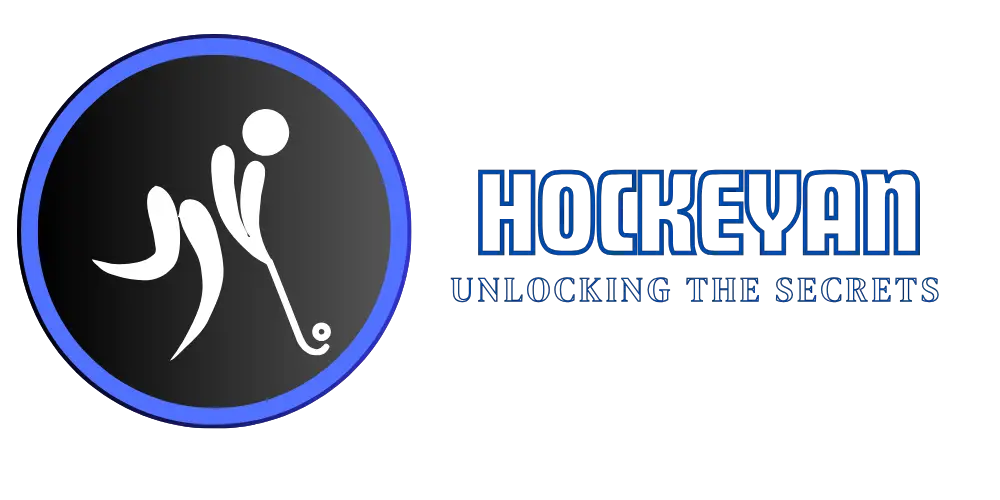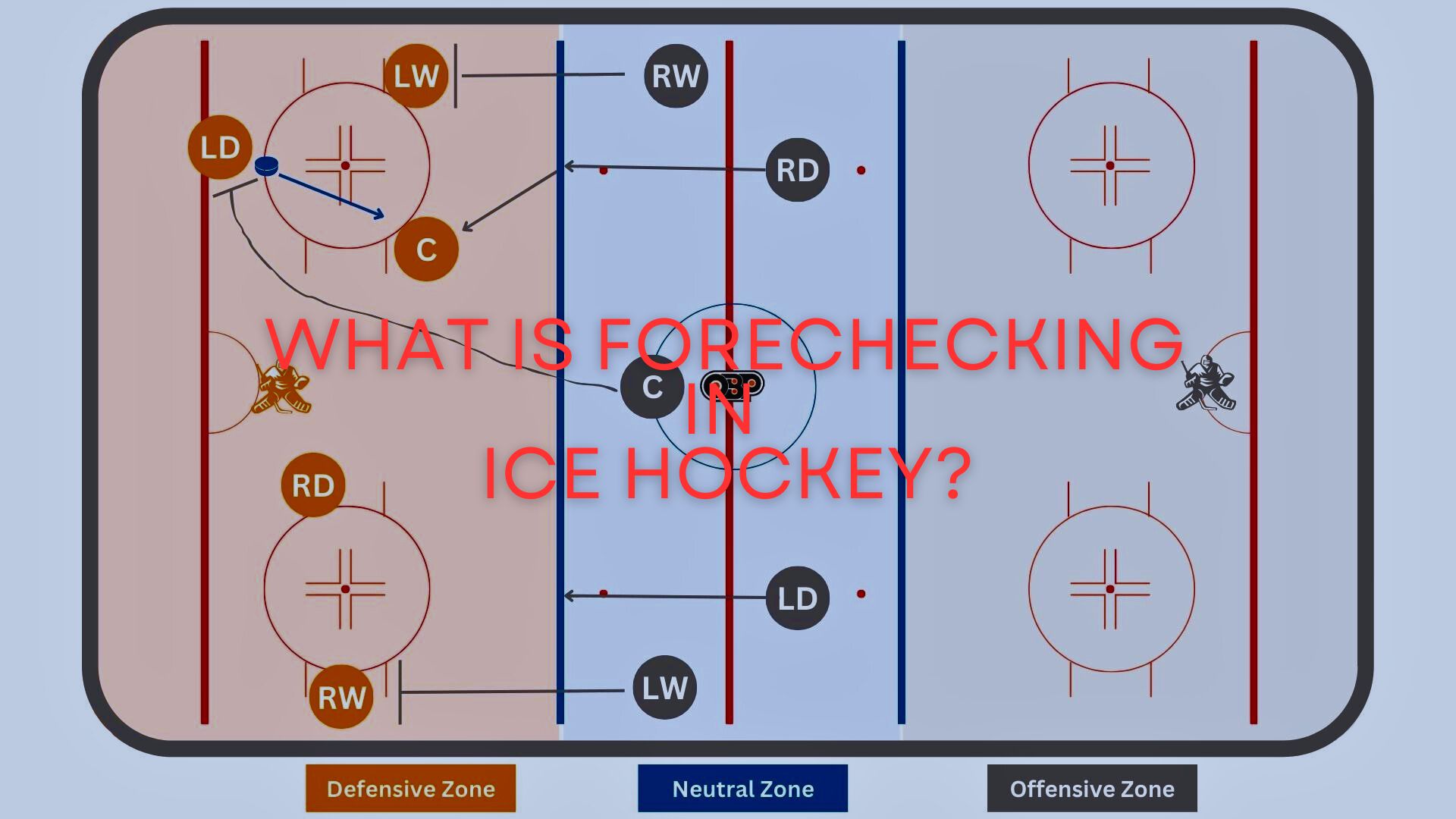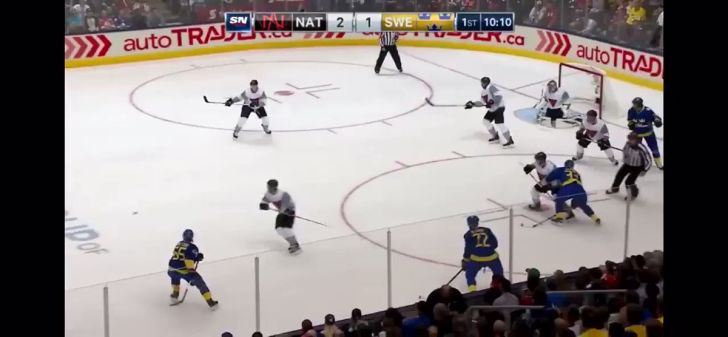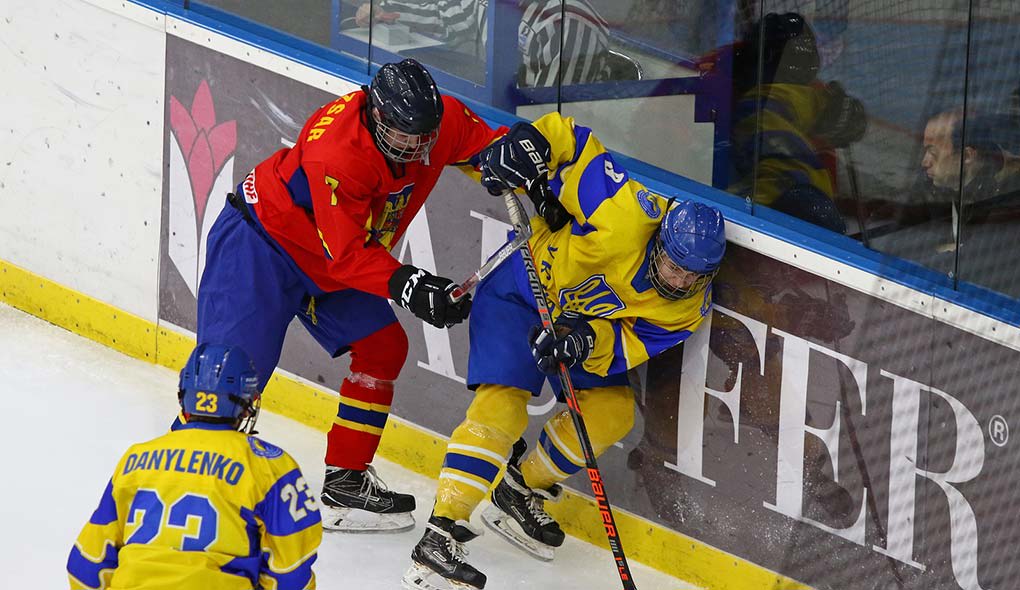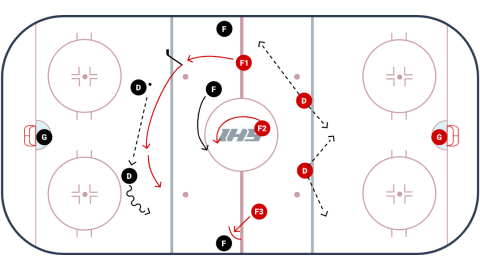What is forechecking in ice hockey? Forechecking is a defensive strategy used to disrupt the opposing team’s offensive play. Players apply pressure in the offensive zone to regain puck control.
Forechecking is crucial in ice hockey as it prevents the opponent from setting up plays. It involves players aggressively pursuing the puck carrier in the offensive zone. This tactic forces turnovers and creates scoring opportunities. Different forechecking systems include the 1-2-2, 2-1-2, and 1-3-1, each with unique formations and purposes.
Teams choose their forechecking style based on their strengths and the opponent’s weaknesses. Effective forechecking requires speed, anticipation, and teamwork. It can change the momentum of the game, making it a vital part of a team’s strategy.
Introduction To Forechecking In Ice Hockey
Ice hockey is a fast and thrilling sport. One key aspect is forechecking, which helps teams regain possession of the puck. It is crucial for both offence and defence.
The Basics
Forechecking occurs in the opponent’s zone. Players pressure the puck carrier, aiming to force mistakes and regain the puck. Different forechecking systems exist.
- 1-2-2 System: One player pressures the puck, two support, and two defend.
- 2-1-2 System: Two players attack the puck, one supports, and two defend.
- 1-3-1 System: One player pressures, three form a line, and one defends.
Importance In-Game Strategy
Forechecking is a vital in-game strategy. It disrupts the opponent’s play, allowing teams to control the game’s tempo. A good forecheck creates scoring chances and tyres out the opposing team.
Effective forechecking requires communication. Players need to understand their roles and read the game well. Coaches often train teams to perfect their forecheck.
| Forechecking System | Key Players | Objective |
|---|---|---|
| 1-2-2 | Forward, Wingers, Defensemen | Regain Puck, Control Play |
| 2-1-2 | Two Forwards, Center, Defensemen | High Pressure, Quick Turnovers |
| 1-3-1 | Forward, Three Midfielders, Defensemen | Block Passing Lanes, Force Errors |
Credit: hockeysarsenal.substack.com
Types Of Forechecking Systems
Forechecking is a vital part of ice hockey. It helps teams gain control and create scoring chances. There are several types of forechecking systems, each with a unique strategy and purpose. Let’s explore the most common ones.
1-2-2 System
The 1-2-2 system is popular in hockey. It is easy to learn and effective. In this system, one forward pressures the puck carrier. The two other forwards stay behind. They block passes and support the first forward. The two defensemen stay back. They guard the blue line.
This system creates a strong defence and limits the opposing team’s options. The 1-2-2 system is great for neutral zone play and allows quick transitions to offence.
2-1-2 System
The 2-1-2 system is more aggressive. Two forwards pressure the puck carrier. The third forward stays in the middle. He supports the first two forwards. The two defensemen stay back. They guard the blue line and watch for breakaways.
This system puts pressure on the opposing team, can force turnovers, and creates scoring chances. The 2-1-2 system requires good communication and quick reactions.
1-3-1 System
The 1-3-1 system is unique. One forward pressures the puck carrier. Three players form a line behind him. They block passes and cover the ice. The last defenseman stays back. He guards the blue line.
This system creates a solid wall and limits the opposing team’s options. The 1-3-1 system is great for trapping teams and allows quick transitions to offence.
| System | Key Features |
|---|---|
| 1-2-2 | Strong defence, easy to learn, effective in neutral zone |
| 2-1-2 | Aggressive, creates pressure, requires good communication |
| 1-3-1 | Solid wall, limits options, great for trapping teams |
Key Tactics For Effective Forechecking
Forechecking is crucial in ice hockey. It involves pressuring the opponent in their zone. Effective forechecking can lead to turnovers and scoring chances.
Puck Pressure
Puck pressure means putting immediate pressure on the puck carrier. The goal is to limit their time and space, which can lead to mistakes and poor decisions.
Players must be quick and aggressive. They should skate hard toward the opponent. Stick positioning is vital. It blocks passing lanes and forces the puck carrier to make errors.
Forcing Turnovers
Forcing turnovers happens when the forechecking team wins the puck back. This can be achieved through body checks, stick checks, and intercepting passes.
- Body checks disrupt the puck carrier.
- Stick checks poke the puck away.
- Intercepting passes stops the opponent’s play.
Turnovers create quick transitions. They allow the attacking team to catch the opponents off guard.
Creating Scoring Opportunities
Effective forechecking creates scoring opportunities. Once the puck is won back, the team can attack immediately.
Quick passes and shots are key. Players should look for open teammates and shooting lanes.
| Action | Result |
|---|---|
| Win the puck back | Gain possession |
| Quick pass | Find open teammate |
| Take a shot | Scoring chance |
Creating scoring chances quickly can lead to goals. This is the ultimate goal of forechecking.
Credit: blog.purehockey.com
Roles And Responsibilities
Forechecking is a key strategy in ice hockey. It involves players putting pressure on the opposing team to regain control of the puck. Understanding the roles and responsibilities of each player during forechecking is crucial for a successful game. This section will delve into the specific duties of forwards and defensemen during forechecking.
Forwards’ Role
Forwards are the main players involved in forechecking. Their primary goal is to disrupt the opposing team’s breakout and regain possession of the puck.
- First Forward (F1): The first forward puts immediate pressure on the puck carrier.
- Second Forward (F2): The second forward supports F1 by covering passing lanes.
- Third Forward (F3): The third forward stays higher in the zone to prevent odd-man rushes.
Forwards must work together to trap the puck in the offensive zone. This coordinated effort helps create scoring opportunities.
Defensemen’s Support
Defensemen play a crucial role in supporting the forecheck. Their responsibilities include maintaining a strong defensive position and being ready to react to the play.
- Pinching: Defensemen may move up to keep the puck in the zone.
- Gap Control: They must control the space between them and the forwards.
- Communication: Defensemen must communicate with forwards to ensure coverage.
Effective support from defensemen helps prevent breakouts and keeps the pressure on the opposing team.
Understanding these roles is essential for successful forechecking. Both forwards and defensemen must work together to apply pressure and regain control of the puck.
Executing A Successful Forecheck
Executing a successful forecheck is crucial in ice hockey. It disrupts the opposing team’s play. The forecheck helps regain puck control. Here’s how to manage it effectively.
Timing And Positioning
Proper timing and positioning are key to a successful forecheck. Players must anticipate the puck’s movement. They should be in the right place at the right time. This means reading the game well.
Good positioning involves:
- Staying close to the boards
- Blocking passing lanes
- Keeping an eye on the puck
Players should take their time and maintain a strategic approach, which ensures the team remains defensively strong.
Communication And Teamwork
Communication and teamwork are vital for an effective forecheck. Players must constantly talk to each other and know their roles and responsibilities.
Effective communication includes:
- Calling out plays
- Alerting teammates about opponents
- Providing support during pressure
Teamwork ensures players cover all areas. It helps in quick transitions. This makes the forecheck more efficient.
Challenges And Solutions
Forechecking in ice hockey is a vital strategy. It involves pressuring the opponent in their defensive zone, aiming to regain possession and create scoring opportunities. Yet, forechecking comes with challenges. Here, we will discuss these challenges and offer solutions.
Dealing With Fast Breakouts
Fast breakouts can disrupt forechecking efforts. Opponents can quickly transition from defence to offence, making it hard to maintain pressure.
To counter fast breakouts, players need to:
- Improve skating speed
- Maintain proper positioning
- Anticipate opponent movements
A team can also use a 1-2-2 forechecking system. This setup has one forward pressuring the puck, two forwards covering the neutral zone, and two defensemen staying back. This reduces the risk of getting caught in a fast breakout.
Overcoming Defensive Traps
Defensive traps are another challenge in forechecking. Teams use traps to slow down the forecheck and force turnovers.
To overcome defensive traps, players should:
- Use quick, short passes
- Keep the puck moving
- Spread out to create space
Using a 2-1-2 forechecking system can also help. This system involves two forwards deep in the offensive zone, one forward high, and two defensemen at the blue line. It creates pressure and forces the opponent to make quick decisions.
Forechecking requires practice and coordination. Teams must adapt to different situations and opponents. By improving speed, positioning, and puck movement, teams can overcome these challenges.
Case Studies Of Successful Forechecking
Understanding the intricacies of forechecking can elevate a team’s performance. By analyzing” successful case studies, we can see how different strategies lead to victories. Below, we dive into how NHL teams have mastered forechecking and break down legendary games where forechecking played a pivotal role.
NHL Teams’ Strategies
Several NHL teams have perfected the art of forechecking. They use different tactics to apply pressure on their opponents.
| Team | Strategy | Key Players |
|---|---|---|
| Boston Bruins | 1-2-2 Formation | Patrice Bergeron, Brad Marchand |
| Los Angeles Kings | 2-1-2 Formation | Anze Kopitar, Dustin Brown |
| St. Louis Blues | Heavy Forecheck | Ryan O’Reilly, Vladimir Tarasenko |
The Boston Bruins often use a 1-2-2 formation, which clogs the neutral zone and forces turnovers. The Los Angeles Kings prefer a 2-1-2 formation, which is aggressive and creates scoring opportunities. The St. Louis Blues use a heavy forecheck, which wears down the opposition.
Legendary Games Analysis
Some games are remembered for their exceptional forechecking. These matches showcase how effective forechecking can change the outcome.
- 2011 Stanley Cup Finals – Boston Bruins vs. Vancouver Canucks
- 2014 Western Conference Finals – Los Angeles Kings vs. Chicago Blackhawks
- 2019 Stanley Cup Finals – St. Louis Blues vs. Boston Bruins
In the 2011 Stanley Cup Finals, the Bruins used relentless forechecking. This led them to victory over the Canucks. During the 2014 Western Conference Finals, the Kings’ aggressive forechecking broke the Blackhawks’ defence. The 2019 Stanley Cup Finals saw the Blues overpower the Bruins with their heavy forecheck.
By analyzing these case studies, teams can learn and adopt these successful forechecking techniques.
Improving Your Team’s Forechecking
Forechecking is a crucial skill in ice hockey. It can create scoring opportunities. Effective forechecking disrupts the opponent’s play. Improving this can elevate your team’s game. Focus on specific drills and learn from the pros to master forechecking.
Drills And Exercises
Drills and exercises are key to improving forechecking skills. Here are some effective drills:
- The 1-2-2 Drill: This drill helps players understand positioning. It focuses on pressuring the puck carrier.
- The 2-1-2 Drill: This drill emphasizes aggressive forechecking. Players learn to apply pressure and force turnovers.
- Gap Control Drill: This drill teaches players to maintain proper spacing. It helps them intercept passes and block lanes.
- Chase and Contain Drill: This drill focuses on tracking the puck. Players learn to contain the puck carrier effectively.
Learning From The Pros
Watching professional players can provide valuable insights. Analyze their strategies and techniques. Here are some tips:
- Watch Game Footage: Study how pros position themselves. Notice their timing and movements.
- Follow Specific Players: Focus on players known for strong forechecking. Observe their decision-making process.
- Practice Mimicking Moves: Try to replicate the pros’ moves during practice. This can help in understanding their techniques better.
- Attend Professional Games: If possible, watch games live. This gives a better perspective on the ice dynamics.
Improving your team’s forechecking requires dedication and practice. Use these drills and learn from the best.
Credit: www.icehockeysystems.com
Frequently Asked Questions
What Is The Difference Between Forecheck And Backcheck?
Forecheck involves players pressuring opponents in their defensive zone to regain puck control. Backcheck means players rush back to their defensive zone to stop the opponent’s attack.
What Are The Basics Of Forechecking?
Forechecking involves pressuring the opponent in their defensive zone to regain puck possession. Key elements include positioning, timing, and aggressiveness. Utilize speed and teamwork to disrupt plays.
How Do You Practice Forecheck?
Practice forecheck by setting up drills with teammates. Focus on positioning, puck pursuit, and creating turnovers. Use game-like scenarios.
What Is A 2/3 Forecheck In Hockey?
A 2/3 forecheck in hockey involves two forwards pressuring the puck carrier, while three players stay back to defend. This strategy balances offense and defense, aiming to create turnovers while maintaining defensive stability.
Conclusion
Mastering forechecking is essential for any ice hockey team aiming for success. It disrupts the opponent’s play, creating opportunities. Understanding various forechecking strategies enhances both individual and team performance. Keep practicing and refining your skills to stay ahead of the competition.
Elevate your game by mastering this crucial aspect of ice hockey.
